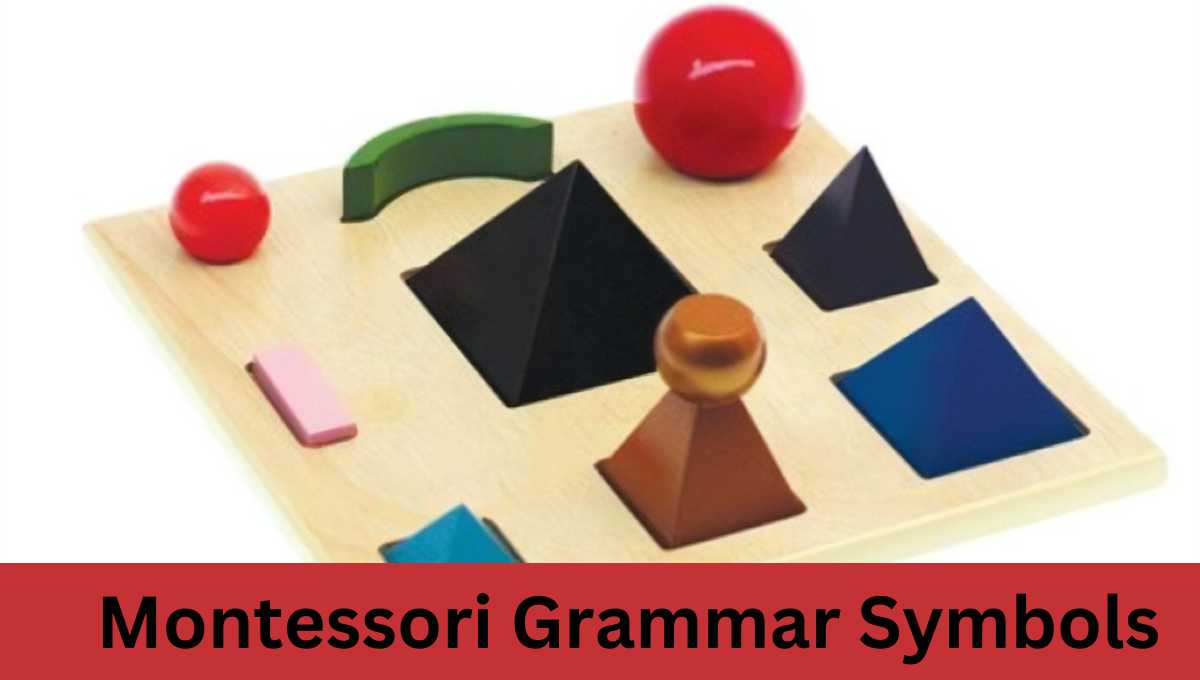Introduction to Montessori Grammar Symbols
In the world of education, there’s a unique approach known as Montessori, and within it lies a fascinating tool called Montessori grammar symbols. Imagine learning about words and sentences not just through books, but with the help of colorful symbols that make language come alive for young minds.
What are Montessori Grammar Symbols?
Montessori grammar symbols are a set of special shapes and colors designed to represent different parts of speech. They are like a secret code that helps children understand the building blocks of sentences. Each symbol stands for a specific word type, like a noun (a person, place, thing, or idea), a verb (an action word), or an adjective (a describing word).
Why Use Symbols?
Now, you might wonder, why use symbols instead of just words? Well, Dr. Maria Montessori, the brain behind this method, believed that using symbols engages both the visual and tactile senses, making learning more fun and effective.
How Do They Work?
Picture this: a black triangle for a noun, a red circle for a verb, and so on. These symbols are like friends that join together to create sentences. When children see and touch them, it’s not just about memorizing words; it’s about understanding how words fit together to make meaningful sentences.
Making Language Fun and Colorful
In the Montessori classroom, you’ll find children playing with these symbols, arranging them to form sentences, and discovering the magic of language. The colors and shapes turn grammar into a colorful journey, making it easier for young learners to grasp the rules of language in an exciting way.
The Birth of Montessori Grammar Symbols
The story begins with Dr. Maria Montessori, a remarkable lady who wanted to make learning a thrilling journey for children. Back in the early 1900s, she observed that kids are like sponges, soaking up knowledge best when they can see, touch, and play.
Maria Montessori’s Bright Idea
Dr. Montessori believed that if learning was fun and hands-on, it would stick with children longer. So, she came up with the ingenious idea of using symbols to teach grammar. Imagine learning about words not just from a dull textbook, but through vibrant shapes and colors!
Creating the Code of Language
Montessori didn’t just randomly pick shapes and colors. She carefully designed each symbol to represent a different part of speech – like a black triangle for a noun or a red circle for a verb. It’s like a secret code that unlocks the mysteries of sentences.
Why Symbols?
You might wonder, why symbols? Well, Dr. Montessori knew that using symbols engages both the eyes and the hands. When children play with these symbols, arranging them like pieces of a puzzle, they’re not just memorizing words; they’re understanding the puzzle of language.
Growing in the Montessori Classroom
As Montessori schools started popping up around the globe, so did these grammar symbols. Children in these classrooms began to explore language in a whole new way – through play and discovery. The symbols became tools for teachers to show how words come together to create meaning.
The Legacy Lives On
Today, Montessori grammar symbols continue to be a key part of this special way of learning. They’re not just shapes on a page; they’re the legacy of a brilliant idea that learning should be an adventure, and language, a colorful exploration.
The Purpose of Montessori Grammar Symbols
In the Montessori world, learning about words isn’t just about reading from a book; it’s an exciting adventure guided by something special – grammar symbols. These symbols, like colorful codes, have a specific purpose that makes learning language a whole lot of fun.
Making Learning Playful
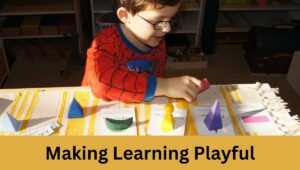
Imagine learning grammar like playing with colorful toys. That’s the idea behind Montessori grammar symbols. They turn the sometimes-tricky rules of language into a game. Instead of just reading about nouns and verbs, children get to touch, move, and play with these symbols.
Hands-On Understanding
The symbols aren’t just pretty shapes; they’re tools that help children understand the building blocks of sentences. When kids see and touch a red circle (representing a verb, the action word), it’s like holding the magic of a sentence in their hands. It’s hands-on learning that sticks.
Engaging Senses
Dr. Maria Montessori, the brain behind this method, knew that learning is more powerful when it involves our senses. The symbols engage both the eyes and hands, creating a sensory experience. It’s not just about looking at words; it’s about feeling the language come alive.
Grasping Sentence Structure
Ever tried to solve a puzzle without knowing where the pieces fit? Montessori grammar symbols are like puzzle pieces for language. Children arrange them to create sentences, and in doing so, they understand how words fit together. It’s like discovering the secret recipe of language.
Fun and Meaningful Learning
The ultimate goal is to make learning meaningful. When children play with these symbols, they’re not just memorizing boring grammar rules. They’re actively participating in the adventure of language, turning learning into a joyful and memorable experience.
Setting the Foundation
Montessori education believes in setting a strong foundation for a lifetime of learning. By introducing grammar symbols, children build a solid understanding of language early on, laying the groundwork for confident and capable communicators in the future.
How Montessori Grammar Symbols Teach Us Language
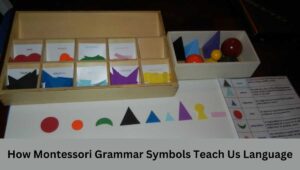
In a Montessori classroom, learning grammar isn’t about boring lectures or endless worksheets. It’s more like a colorful game where symbols become our playmates in understanding the secrets of language.
Sorting and Matching
Imagine a big box of colorful symbols – circles, triangles, squares, and more. These symbols represent different parts of speech like nouns, verbs, and adjectives. Kids start by sorting them, matching the symbols with the right words. It’s like a word treasure hunt!
Building Sentences
Once the symbols are sorted, it’s time to build sentences. A red circle for a verb, a black triangle for a noun – these symbols come together like puzzle pieces to create meaningful sentences. Kids arrange them in order, and voila! They’ve just built a sentence.
Hands-On Exploration
The symbols aren’t trapped in books; they’re meant to be touched and moved. Children use their hands to explore language. Holding a symbol helps them connect with the idea behind the word – whether it’s an action (verb) or a thing (noun).
Colorful Coding
The colors of the symbols aren’t just for show. They’re like a secret code that helps kids remember the roles of words. Green for articles, red for verbs – associating colors makes it easier for little learners to recall and understand the different parts of speech.
Story Creation
The symbols aren’t just tools for building sentences; they’re also magic wands for crafting stories. Kids use them to create their own tales, adding symbols like characters in a story. It’s storytelling made hands-on!
Moving Beyond the Symbols
As children get comfortable with the symbols, they start to connect them with real words. The symbols become a bridge between the abstract world of grammar and the words we use every day. It’s like learning a secret language that helps us express ourselves.
Fun and Learning Hand in Hand
In the Montessori world, learning is never dull. The symbols turn grammar into a playful adventure. It’s not about memorizing rules; it’s about exploring and discovering the wonderful world of words in an engaging and enjoyable way.
Discovering the Colorful World of Montessori Grammar Symbols
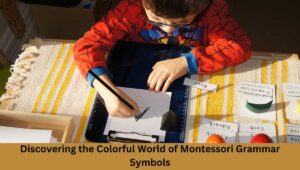
In the Montessori classroom, language becomes an exciting adventure with the help of special symbols. Each symbol has its own role, like characters in a story, making grammar a colorful journey.
Noun Symbol (Black Triangle)
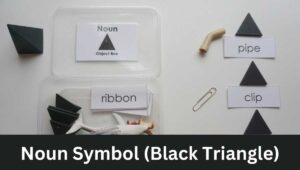
- Imagine a black triangle. This symbol represents a noun, which is a person, place, thing, or idea. It’s like a little flag for naming things in our sentences.
Article Symbol (Green Triangle)
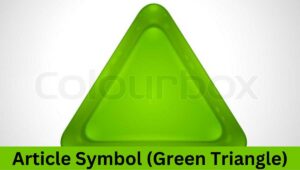
- Now, think of a green triangle. This one stands for articles – those little words like ‘a,’ ‘an,’ and ‘the’ that come before nouns. They’re like helpers that introduce nouns to the sentence.
Adjective Symbol (Blue Triangle)
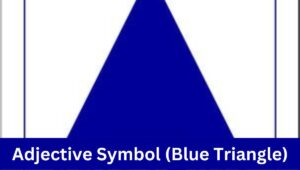
- The blue triangle represents adjectives, the words that describe or add more details to nouns. It’s like adding colors to our nouns to make them more interesting.
Verb Symbol (Red Circle)
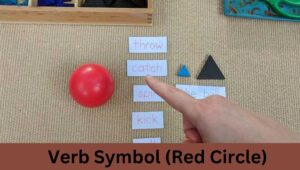
- Picture a red circle. This symbol is all about verbs, the action words that tell us what’s happening. It’s like capturing the movement in our sentences.
Adverb Symbol (Orange Circle)
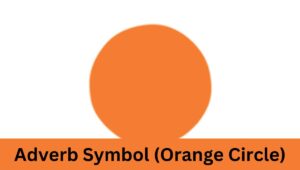
- Now, an orange circle comes in. It stands for adverbs, which describe how an action happens. They add details to our verbs, like saying ‘quickly’ or ‘happily.’
Preposition Symbol (Purple Square)
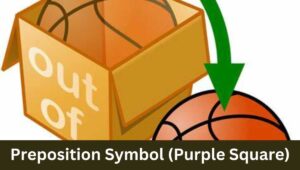
- Think of a purple square. This symbol is for prepositions, little words that show relationships between things. They help us understand where or when something is happening.
Conjunction Symbol (Yellow Square)
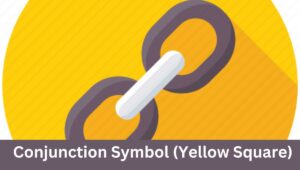
- Now, a yellow square joins the party. It represents conjunctions, words that connect other words or ideas. Like ‘and,’ ‘but,’ or ‘because’ – they’re like sentence glue.
Pronoun Symbol (Brown Oval)
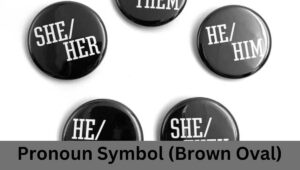
- Imagine a brown oval. This symbol is for pronouns, words that take the place of nouns. Instead of saying a name over and over, we can use pronouns like ‘he,’ ‘she,’ or ‘it.’
Interjection Symbol (Pink Diamond)
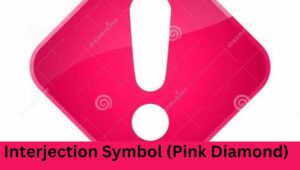
- Lastly, think of a pink diamond. This one represents interjections, words that express strong feelings, like ‘wow’ or ‘ouch.’ They add a dash of emotion to our sentences.
Sentence Symbol (Large Black Triangle)
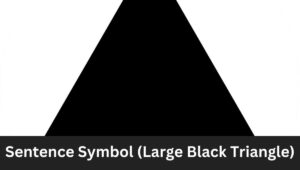
- Combining two black triangles creates a big one. This large black triangle symbolizes a complete sentence. It’s like the finishing touch that brings everything together.
Bringing Language to Life in the Classroom
In the magical world of Montessori classrooms, learning grammar is like going on a fun adventure with colorful symbols. Here’s how these special symbols come to life in the classroom:
Symbol Play Stations
- Imagine little stations in the classroom, each with a set of symbols. Children get to explore these stations, touching, arranging, and playing with the symbols. It’s like a grammar playground!
Building Sentences
- Picture kids sitting together with their symbols, creating sentences like sentence architects. A red circle for a verb, a black triangle for a noun – they arrange these symbols to construct sentences, turning learning into a hands-on construction project.
Storytelling with Symbols
- Symbols aren’t just for sentences; they’re story tools too! Children use them to craft their own imaginative tales. It’s like weaving a story using these colorful language threads.
Symbol Hunt and Match
- Teachers create a playful game where kids search for symbols that match specific words or parts of speech. It’s a symbol treasure hunt, making learning a thrilling adventure.
Colorful Coding
- Each symbol has its own color, creating a visual code for different parts of speech. Teachers use this colorful coding to help children remember and understand the roles of words in a sentence.
Interactive Activities
- From games to group activities, Montessori classrooms buzz with interactive ways to use grammar symbols. Whether it’s a symbol relay race or a group sentence-building activity, learning becomes an engaging and collaborative experience.
Personalized Learning
- Every child learns at their own pace. Montessori classrooms embrace this by allowing each child to explore grammar symbols at their speed. It’s like a personalized language journey tailored to each student’s unique learning style.
Connecting Symbols to Words
- As children become familiar with symbols, teachers guide them in connecting symbols to real words. It’s a bridge between the symbolic world of grammar and the everyday language they use.
Celebrating Achievements
- Small victories are big in Montessori classrooms. Teachers celebrate when a child successfully creates a sentence or identifies a symbol. It’s about recognizing effort and making learning a joyful experience.
Making Language Fun
- The overall goal is to make learning grammar enjoyable. Montessori classrooms infuse playfulness into language exploration, ensuring that every child associates language with fun, creativity, and discovery.
